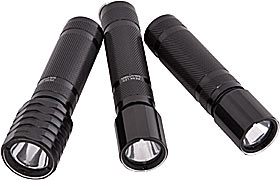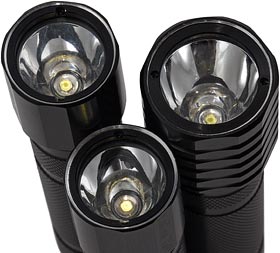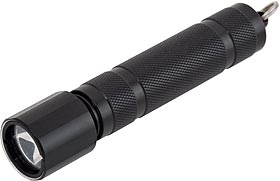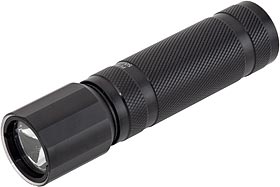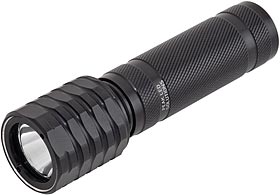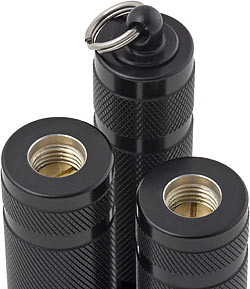
Peak LED Solutions mini LED flashlights
Review date: 24 March 2006 Last modified 03-Dec-2011.
How big is a pocket flashlight?
Yes, wiseacres, it does depend on the size of your pocket. But the real limiting factor, for people whose clothes actually have pockets of reasonable utility, is how much bulk you're willing to put up with in a pocket.
You can fit an R/C car in one jeans pocket and four tanks in the other, but you probably don't want to. That much junk is uncomfortable, and will also of course make your pockets look like a chipmunk's face.
If you want to avoid Visible Flashlight Line in your pants, some super-small light like a Photon Micro-Light or some credit card shaped doodad is your only option.
Such lights generally work perfectly well, but battery technology just isn't good enough for them to have decent run time. Many people get years of service out of one set of batteries for a Photon-type light, but for most of that time it's trickling along on the last little slice of battery power, emitting a small fraction of the light it did when it was new.
For finding keyholes and vaguely illuminating where your feet are going when your eyes are night-adapted, a dim light like that is fine. Plenty of people have done those jobs by the light of their mobile phone screen, after all.
If you want decent brightness for a reasonable length of time, you need something that runs from a bigger battery. Preferably not a battery you have to file a NATO requisition form for, either.
Lights powered by AAA cells are deservedly popular, because the batteries are cheap and common, and they've got enough grunt and capacity to deliver decent brightness from modern LEDs, but they're skinny enough to make the flashlight not a lot bulkier than a cigarette.
Lots of people bought the Maglite Solitaire when it was the only AAA-cell flashlight option out there, even though it really didn't work very well. That was all down to its tiny incandescent bulb. LED lamps were just made for AAA lights, once people figured out how to cram a little step-up DC to DC converter into one of them to push the 1.5-volts-or-less of the battery to the 3.6-volts-or-near-offer that white LEDs need.
Those converters are quite efficient, so they don't waste a lot of the battery's capacity, and a humble AAA alkaline has about 3.5 times the nominal energy of the two CR2016 coin cells that power most key-ring lights, even before you consider the horrible violence that powering a bright LED does to CR2016 capacity.
Still, though, three bright white LEDs is about the limit for an alkaline AAA. That's what Peak LED Solutions' "Matterhorn" light, which I reviewed a while ago, uses. The Matterhorn's battery life is acceptable - three to four official hours of on-time before it dims to half of its original brightness. But if you want any more light than the Matterhorn delivers, you'll lose battery life faster and faster, as the higher load reduces the AAA cell's effective capacity. Alkalines don't like high current operation.
If you want more power out of a AAA cell, there are two options.
Option one: Go all exotic and specify a non-rechargeable lithium AAA for your light. Not a terrible idea, because (a) lithium AAAs, as well as AAs, actually exist now (PDF datasheet here), and (b) a light that'll run from a lithium AAA can easily be made to run at lower power from an alkaline, or even a plain carbon-zinc "dry cell".
But this isn't a great idea either, because lithium AAAs don't actually offer a whole lot more juice than an alkaline cell. Actually, the top-flight premium brand alkalines have a bit more nominal capacity than AAA lithiums (though not enough to make them good value - cheap alkalines are good alkalines).
Lithium AAAs can deliver most of their nominal capacity even if you ask for a whole amp of current, which is rather more than you can expect from an alkaline AAA. But at one amp, you still only get a bit more than one hour of run time. Then it's time for another $US4 lithium cell (under $US2, for bulk off-brand cells on eBay. Try your luck!).
Which brings us to option two: Use a rechargeable AAA. You'll have no trouble pulling a couple of watts out of that, which is tons of power for a little pocket light, but now your battery life will be even lousier (not that this discourages some manufacturers).
Top-spec NiMH rechargeable AAAs these days are up to about 900 milliamp-hours (mAh) at their nominal 1.2 volts. There's always a bit of noise in the numbers at the cutting edge of battery development, thanks to the low scruples-to-optimism ratio of various rebranders of the same actual cells, but Sanyo's making 900mAh AAAs now, and they're trustworthy.
900mAh at 1.2 volts means rather more actual energy into a moderate load than an alkaline cell with a 1300mAh rating can deliver - but if you want 1.5 watts from one of those shiny new NiMH AAAs, you're only going to get it for 54 minutes even if the cell's fresh out of the charger. After it's been sitting for a week, self-discharge may easily have reduced the run time to only 30 minutes.
So there's really no solution, short of LED lamps that have the efficiency of fluorescent tubes (they're working on that), except for a plain old bigger battery.
Bite the bullet and go to at least a AA cell, and you can have a reasonably powerful light that isn't that much bigger than a AAA model. A double-A gives you around 2.3 times the rated capacity of a triple-A; under heavier loads it can be more like a factor of three, because bigger cells handle heavier loads better.
And that's what Peak LED Solutions have done, for these three lights.
Peak started out naming their lights after mountains; now they're into bodies of water.
The one on the right is named after Glacier Bay, a place where you don't want to get stuck with one match. The one in the middle is the Kino Bay (no doubt evidence of Peak's appreciation of the picturesque salt evaporation industry); the one on the left is the Mediterranean.
(If you'd prefer links to the actual, um, product pages, rather than yet more products of Dan's Stick A Pin In The Phone Book Link Generator, try Glacier Bay, Kino Bay and Mediterranean. Peak occasionally forget to update the title tags when they're making new Web pages, so some of their product pages have the name of the wrong product on the top of the window. Rest assured that the time they don't spend fixing their Web site, they do seem to spend getting the lights right.)
These lights are basically quite similar. They've all got DC-to-DC regulators behind their Lumileds Luxeon LED lamps, they all use the simple waterproof twist-the-lamp-end switching mechanism (unscrew the lamp entirely to change the battery), they're all made out of black-anodised aluminium, and they're all quite pocketable.
They've all also got rather deep reflectors in their lamp assemblies, which gives them all a narrower beam than most LED flashlights, and practically all LED flashlights around this size.
You can't remove the reflector to use these lights in a bare-lamp "candle mode". You can get at the bare LED, but the retaining ring on the front of the lens screws in and you need something like a pair of snap ring (or "c-clip") pliers to remove it - or a couple of pointy things, a vise, and some patience. Then you can lever out the lens and reflector, if you really want to, but the body of the lamp housing will still be sitting up around the LED.
Only one of these lights actually uses a plain old AA cell. The other two are powered by the standard energy source for little super-bright "tactical" lights, the CR123 lithium cell.
123s, like various other little cylindrical 3.6-volt-nominal lithium cells, were originally made to power cameras. They're significantly shorter and slightly fatter than AAs (with about 95% of the volume), and only officially contain a little more energy than a AA alkaline. But, like lithium AAs and AAAs, they work much better than alkalines into heavy loads. At the moment, nothing can beat them for reliable operation of small flashlights, except for the lithium ion rechargeable 123-size cells that've become common over the last year or two.
If you buy your batteries from the supermarket or, worse yet, the pharmacy or camera store, non-rechargeable CR123s will probably cost you far more than AAs. If you buy in bulk, though (eBay ahoy!), you can get a much better deal. That's a sensible course of action even for home users, because lithiums have a ten-year-plus shelf life. You'll probably find a home for a dozen cells by then.
(Incidentally, most non-rechargeable lithium batteries, including 123s and coin cells, have a nominal potential of three volts per cell. That's because they use the lithium manganese dioxide chemistry, the same as umpteen other non-rechargeable "lithium" batteries. Lithium AA and AAA cells use the 1.7 volt per cell lithium iron disulfide chemistry, which makes them reasonably compatible with devices that expect 1.5 volt dry or alkaline cells.)
Price is not, um, a big selling point for these lights. They're not very expensive by "tactical light" standards, considering how well they're made, but they're still much more expensive than the flashlights most people buy.
The Kino Bay is $US69.95. It's the one that runs from a AA cell, which also means it's the longest - about 106mm (4.2 inches) counting the key-ring lug on the end. It packs a one watt LED, but Peak don't specify what power that LED's actually running at.
LED power is, you see, rather elastic. You can push LEDs to run at more than their rated power, as long as you can keep them cool enough; it's routine for larger flashlights with "three watt" Luxeon LEDs in them to run those LEDs at four or five watts, and with good enough heat sinking that works fine.
You can also run LEDs at less than their rated power, though, and it's often quite a good idea. They run cooler, but they also run more efficiently - you get less light, but you may need (say) a third as much power to make half as much light.
This strategy looks all the more attractive when your light's powered by one little AA cell, of course. Peak specify the Kino Bay as having 1.5 hours of battery life before it fades to half brightness, and they've picked six hours as their somewhat arbitrary dead-battery line.
Unregulated LED lights tail off towards zero light output as the batteries go flat, but can take an amazingly long time to actually get there. There's a point below which an LED just won't "fire" and you get no light at all, but even small unregulated flashlights can deliver a faint glow for weeks. That faint glow is only likely to be useful to you if you're lost in a cave and it's the only light you've got, though. At some point you're going to find the light to be unacceptably dim; that point is the end of the battery life, according to you.
Regulated flashlights like these ones, on the other hand, tail off more sharply, because at the very least they need some power to make the regulator work. Accordingly, there's more validity to the idea that they have a distinct battery life.
They're still much better in this department than boring old incandescent-globe flashlights, though; an incandescent light whose batteries are down to (say) quarter voltage will actually still be outputting the 1/16th of its rated power that you'd expect (because V=IR, and power equals VI), but its output wavelength will also be something in the order of 16 times as long, and visible only to a thermal imager.
The Glacier Bay looks not unlike the Kino, except its body's a bit fatter and it's only about 84mm (3.3 inches) long (the one I got for review has no key-ring lug on the end to make it a bit longer). It costs $US89.95, and it's got a one watt LED specified as running at one watt. Its specified battery life from a CR123 is eight hours; it takes 2.5 hours before it's at half brightness.
The Mediterranean's fatter lamp contains a three watt Luxeon LED, but the light only runs it at 1.5 watts. It costs $US109.95, it's about 90mm (3.5 inches) long without key-ring lug, and its quoted CR123 battery life is ten hours - but with only two hours before 50% brightness.
Infinite diversity
As I mentioned in my old review, Peak LED Solutions have a bit of a thing for modularity. All of their flashlights are, essentially, just a lamp screwed onto a battery tube. But oh, so many possibilities.
Peak make lamps with different coloured LEDs, and they even make "high power" and "standard power" versions of otherwise identical lamps. The ones with an "H" stamped on the positive contact button push the LED harder, for more light, less battery life, and a shorter (but still very long) lamp life.
(LED lamps never burn out unless gravely mistreated, anyway; they just get dimmer as they age. White LEDs also shift in colour, as the phosphor over their blue die gets scalded into uselessness. Unfortunately, the phosphor doesn't just burn away, leaving you with a bright blue flashlight. It just sits there like paint when it's dead.)
You can also get lamps with whole different kinds of LED in them.
Take the Kino Bay, for instance. You can drop thirty bucks on a second head with one standard 5mm LED in it - much less light, but much longer battery life - and swap them at will. The high powered head's for walking around the forest, the low powered one's for reading in your tent.
Peak also make lamps and tubes out of different materials.
All three of the lights I got for review are plain hard-anodised black aluminium, which is the most generally sensible material for flashlights - good electrical conductivity, light, quite tough, doesn't rust. But Peak also make lamps and tubes out of brass and stainless steel. There's no very good reason to choose brass - maybe if you want something that's less likely to spark when you drop it, but it mainly just feels satisfyingly heavy, looks cool, makes your hand smell funny, and usually doesn't cost any more than aluminium.
Stainless steel has the advantage of being even less reactive than aluminium, but once again I suspect most people just buy it for show.
The Mediterranean, for instance, comes in aluminium, brass and steel (steel costs ten bucks extra, brass doesn't).
Here's the Glacier Bay multi-metal page. The Kino Bay has one too. It's called kniobay.html.
Ph33r Peak's l33t Web skillz.
There are key chain plugs that screw into the ends of the lights. They're compatible with every Peak light that has a "lug style" body with a threaded hole in the end (Peak make a few lights with optional "pocket" bodies that're shorter and have no end hole). Only the Kino Bay I got actually had a key ring plug screwed into its tail-hole, for some reason; the chain plugs are one of the very few parts you can't buy separately, so I presume the retail lights are all meant to have one, if they've got a place to install it.
You can, by the way, get a simple flat plug to screw in place of the key ring plug to keep dirt and/or pocket fluff out, or to serve as the basis of your own wiggy screw-on doodad. There's also a momentary switch you can put in place of the standard rear battery contact on the Mediterranean, Glacier Bay and other Peak lights that use the same battery tube (not the Kino Bay), so you can activate the flashlight in true "tactical" fashion with your thumb on its tail. Constant-on still requires you to twist the lamp.
And there are two-AA battery packs for the single-CR123 lights, starting at ten bucks for aluminium or brass, which both let you use the more common batteries. They can also accept a really nice tailcap switch (and it's only five bucks!).
All of this parts-exchange stuff may be a bit too Jedi Swap Meet for most people, but it's still cool to be able to do it.
The plethora of parts does, however, explain the brightness and power consumption figures below. The Kino Bay and Mediterranean I got, you see, have standard lamps. The Glacier Bay I got has an H-stamped high power lamp. There's no option to order a Glacier Bay with a different lamp (though you can of course buy lamps in various colours as accessories), so it would seem that the hopped up H-lamp is the standard issue for the regular $US89.95 light.
On to the volts and amps and stuff.
Electrons and photons
The exact beam width from these flashlights is, as usual, impossible to calculate, because the central bright spot doesn't suddenly cut off, but fades out into the wider and much dimmer spill light (without any of the bright rings and dark spots of your typical sallow yellowish incandescent-bulb beam, I might add).
The spill light is pretty much all direct light from the top of the LED, which hasn't hit the reflector. On lights like these with an opaque lip around the lens, the spill light does cut off pretty sharply at the edge of its circle.
The Kino and Glacier Bay lamps are physically the same, forward of their mounting threads, so they throw light in the same pattern. There's a somewhat smaller than 15 degree wide central spot, with spill light out to a very adequate 60-odd degrees - that's more than enough to see where you're walking, and an unusually tight centre spot for a small flashlight.
The Mediterranean's chunkier lamp has a wider central spot and less spill, but the difference is less than 20% in each case, so it's not a big deal.
Peak specify the Kino, Glacier and Mediterranean as outputting 450, 650 and 1250 candlepower, respectively. The candlepower (or more modern candela) is a measure of intensity in a given direction, so the tighter the beam is, the higher the number you get. I measure lamp brightness in much the same way, with a luxmeter one metre away and in the middle of the beam.
From the Kino Bay with a fresh battery, I got a very respectable 340 lux. That's more than enough brightness for most people's purposes; it's really too bright for a finding-your-way-around-the-house-at-night flashlight, but you can use over-bright lights without killing your night vision by shining them on the ceiling, so that's OK.
The Glacier Bay scored better than 790 lux, with the usual readily measurable second-by-second dimming that you see from all high powered flashlights. The high drain on the battery causes it to lose terminal voltage, which results in less light output, but not drastically enough that you can actually see the dimming - the light meter reading just counts down while you watch.
The Mediterranean, in turn, scored better than 850 lux when first turned on, and counted down in much the same way. Its output is less than 10% brighter than the Glacier Bay's, but its beam is wider, so my results more or less line up with Peak's numbers.
Are these numbers good?
Well, I reviewed the LongBow Micra, a single-CR123 light not unlike the Glacier Bay or Mediterranean, a bit more than a year ago.
Its main beam's a bit wider than the Peak lights', but not a lot wider, and I was very impressed with its 600 lux output. It cost $US70.
The CR123 Peak lights cost a bit more money and offer noticeably higher brightness, plus modular add-ons. So they're not a revolution, but they're still up there with the best.
(I reviewed now-we're-broke-now-we're-not boutique manufacturer Arc Flashlight's Arc-LS almost three years ago. I didn't have a luxmeter then, but I measured it later - it does about 400 lux from a fresh CR123. Peak's $US69.95 AA-cell light still isn't what you'd call cheap, but it's not much dimmer than the $US160 top-spec LS. The LS has a nifty tailcap switch, but it's a Kroll unit - the same as the one Peak sell as a $US5 option for the Kino Bay.)
What about power consumption?
I'm glad you asked.
Running from a fresh AA cell through my multimeter in amps mode - which adds a bit of resistance and thus reduces the current slightly, with regulation adding its own fuzz to the measurements - the Kino Bay lamp drew about 980 milliamps, a figure which stayed constant as the rather alarmed battery's voltage slid down from its initial roughly 1.37 volts under load.
If you draw (almost) a constant amp from a AA alkaline you'll beat it pretty much to death in an hour, so I was interested to see what the Kino lamp did from lower voltage input. Normally, even regulated lamps ease off a bit when the batteries are sagging, so as not to kill them unduly quickly.
From a brand-name rechargeable NiMH AA, well charged and delivering about 1.3 volts under load, the lamp still drew about 960mA. Swapping in a tired old D cell that managed about 1.02 volts open circuit, however, gave no perceptible output at all, and close to no current draw.
Letting the Kino run with the NiMH AA in it until the cell sagged down to about 1.25 volts under load (still a bit above its nominal 1.2 volts) gave much less light and only about 200mA current, though. So that's where the regulation eases off.
This means two things. One: Alkaline cells will work OK in the Kino Bay, even though it won't light at all from a one volt cell. An alkaline cell (or a dry cell, for that matter) with 1V left actually probably has a useful amount of energy still in it, for suitably small values of "useful"; put a couple of such batteries in an unregulated LED flashlight and you'll get a faint luminous-fungus glow.
Two: Rechargeables won't work terribly well. Battery life fine, light not very bright once the dew's off the lily and the battery starts delivering its rated voltage, rather than the extra bit on top you get from a freshly charged cell.
Moving on to the Glacier Bay's H-stamped lamp, I first tried its from the Kino Bay's AA cell, seeing as the two lamps look so similar. Lo and behold, the Glacier lamp lit up just fine from half voltage, drawing 1.02 amps - near as dammit to the same current as the Kino lamp.
From its own battery, the Glacier Bay lamp drew only about 660 milliamps - when it's got more input voltage, a DC-to-DC converter doesn't need to draw as much current for a given output power.
So this is a classic regulated lamp; it draws more current as the battery sags, giving you more consistent light but lousier battery life. Still, 1.5 volts is not far above the totally-empty mark for a CR123, so the Glacier Bay lamp does seem likely to be able to use everything the battery has to give.
The Mediterranean's 3W-at-1.5-watts lamp is, definitely, electrically different; it only drew about half an amp from a fresh CR123. This makes sense, given the higher efficiency you get by running an LED at less than full power.
The Mediterranean lamp failed to light from one volt, but did light from 1.5, drawing an average of about 550mA. At this voltage, though, it flashes rapidly, telling the world that its battery appears to be flat, flat, flat. And, presumably, eking out a bit more life from it.
So Peak's odd run time numbers for the two CR123 lights - more high brightness time for the Glacier Bay, but less total run time, despite the fact that the Mediterranean puts out more light from a fresh battery - make sense. Phew.
Overall
So which one should you buy, if any?
Well, the Kino Bay's the mass market contender. AA cells are practically an international barter currency (the exchange rate of AA cells to triple-blade razor cartridges presumably depends on the hirsuteness of the local population and the darkness of the local nights), and the Kino has a winning combination of low(er) purchase price, compact size, more than adequate brightness for a light this small, and neat-o optional extras. It's also the right light to give to someone non-technical as a gift, because you know they won't end up paying $15 for one battery at the nearest branch of Just Leave Your Wallet Here Electronics.
Of the other two, the Mediterranean's the brightest and most efficient, but the Glacier Bay's a bit more pocketable and cheaper to buy. So it's a toss-up between the two, if you ask me.
The clincher here, for me at least, is the plethora of options. The two CR123 lights are better than many other lights that cost the same or more, but not stunningly so - but you can get various extra bits. And, most importantly, these things come in brass, people.
Yes, yes, stainless steel is more practical and, really, there's no sensible reason to go for anything other than anodised aluminium - but brass has style.
The brass "McKinley" I reviewed last time has a light patina on it now, making it look even more marvellously retro-futuristic than it did when it was new and shiny. And if you're in a hurry, you can conduct experiments to make your flashlight look a hundred years old overnight.
Feel free to get the sensible lightweight black versions if you like. But if you're not counting every gram for your upcoming space launch, get yourself a brass Peak light and you'll have something that's still cool even when the LED in it's 50 generations out of date.
Recommended.
Review lights kindly provided by Peak LED Solutions.
